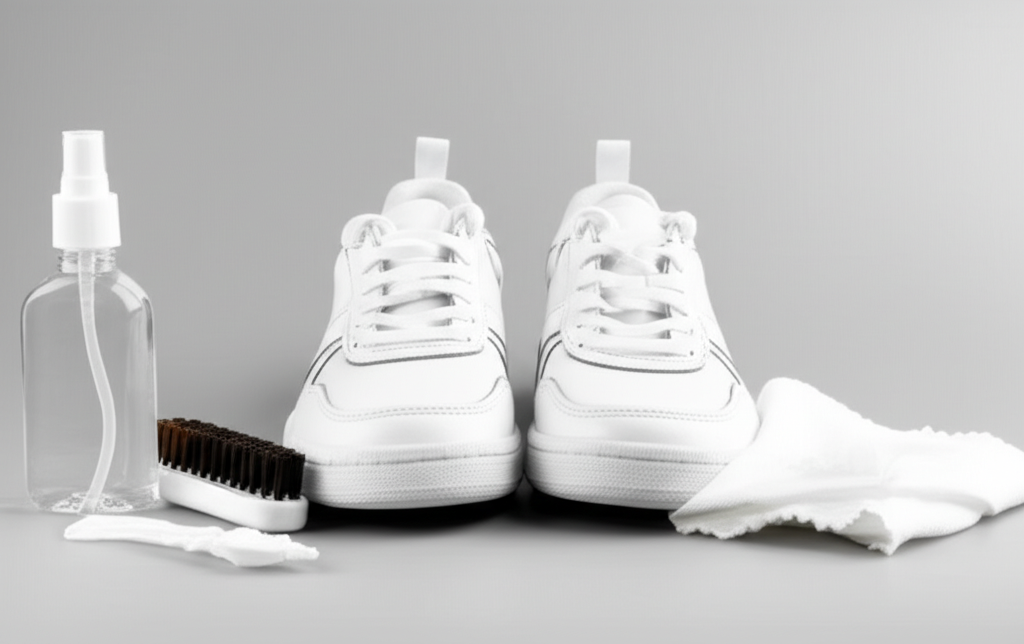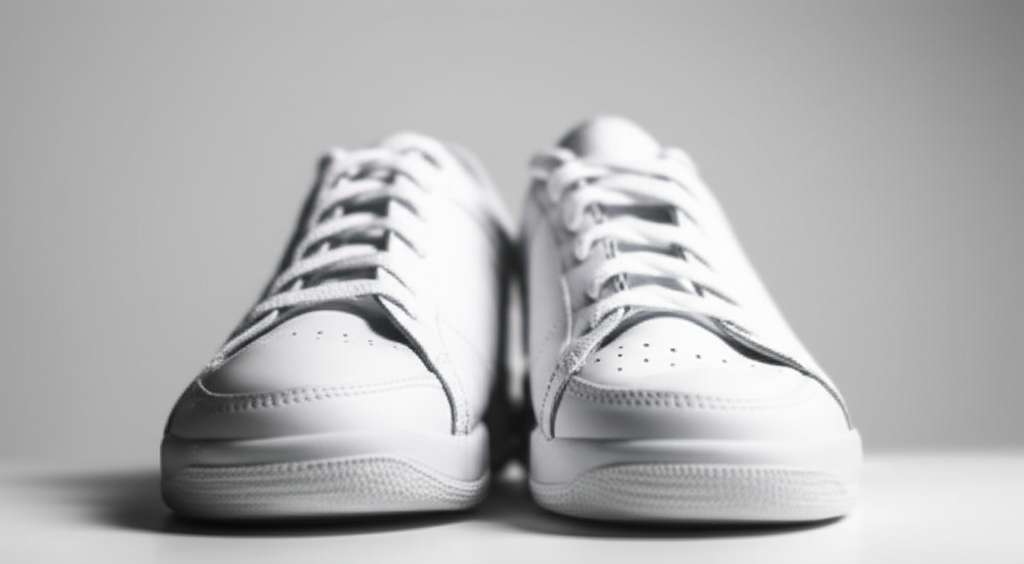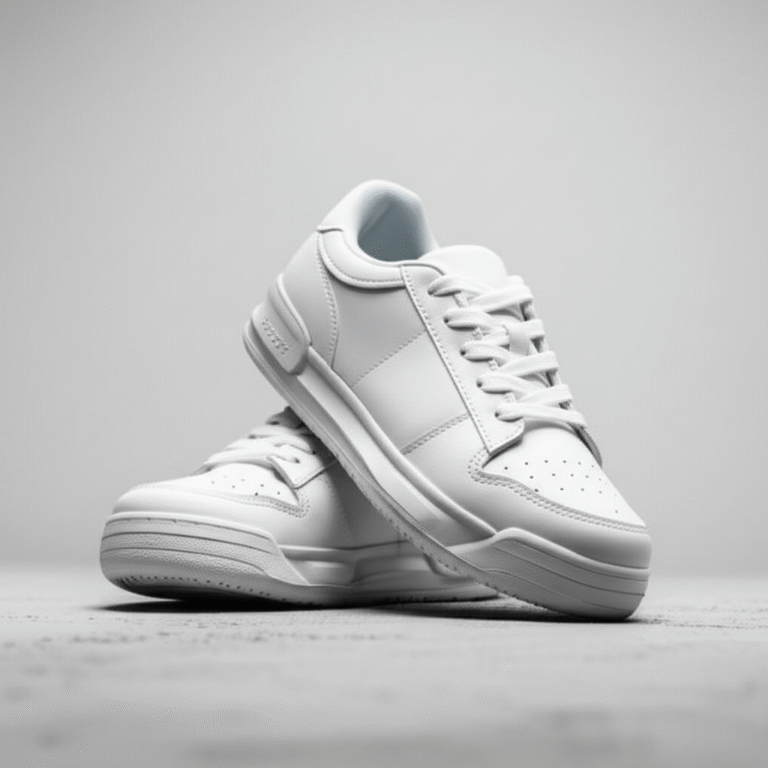To achieve an effortless shine on your white shoes, use a gentle cleaning solution like mild soap and water, baking soda paste, or specialized white shoe cleaners. Always test in an inconspicuous area first and use soft brushes or cloths to avoid damaging the material.
Key Takeaways
- Use mild soap and water for general cleaning.
- Baking soda paste tackles tough stains effectively.
- Magic Erasers work well on rubber soles.
- Protect your clean white shoes from future dirt.
- Choose cleaning methods based on shoe material.
- Regular, gentle cleaning prevents deep-set stains.
What to Clean White Shoes With: Effortless Shine
White shoes are a fashion staple, effortlessly elevating any outfit. But keeping them pristine can feel like a daunting task. Stains, scuffs, and yellowing can quickly turn your crisp white kicks into a dingy mess. It’s common to wonder about the best way to tackle this, especially with so many different shoe materials out there. Don’t worry, you don’t need a professional cleaner to restore their brilliance. This guide will walk you through simple, effective methods to clean white shoes and make them shine like new again. Get ready to discover the secrets to effortless white shoe maintenance.
Understanding Your White Shoes: Material Matters

Before you grab any cleaning product, it’s crucial to identify what your white shoes are made of. Different materials require different care. Using the wrong cleaner can lead to discoloration, damage, or even permanent stains. Most white shoes are made from one or a combination of these common materials:
- Leather: Smooth or pebbled leather is durable but can be prone to scuffs and water stains.
- Canvas/Fabric: These are common for sneakers and often breathable but absorb stains easily.
- Synthetic Leather/PU: Often found in fashion sneakers, these mimic leather but can be more sensitive to harsh chemicals.
- Mesh: Lightweight and breathable, mesh is great for athletic shoes but can snag or stretch if cleaned too aggressively.
- Rubber/Plastic: This is typically used for soles, toe caps, and other accents. It’s generally robust but can yellow over time.
Knowing your shoe’s material will help you choose the safest and most effective cleaning method. For instance, harsh scrubbing or certain chemicals can be too aggressive for delicate mesh or treated leather.
Essential Tools for White Shoe Cleaning
Gathering the right tools before you start makes the cleaning process much smoother. You likely have most of these items already in your home:
- Soft-bristled brushes: An old toothbrush or a dedicated shoe brush is perfect for scrubbing without damaging the material.
- Microfiber cloths: These are gentle, absorbent, and great for wiping away dirt and applying cleaners.
- Cotton swabs/balls: Ideal for reaching small crevices and applying cleaner precisely.
- Bowl: For mixing cleaning solutions.
- Water: Lukewarm water is best for most cleaning tasks.
- Mild soap: Dish soap or laundry detergent works well.
- Baking soda: A natural abrasive and whitener.
- White vinegar: Good for tackling some stains and odors.
- Magic Eraser (melamine foam): Excellent for rubber soles and scuffs on smooth surfaces.
- Protective gloves: To keep your hands clean and protected from cleaning agents.
Having these on hand ensures you’re prepared for various types of dirt and stains your white shoes might encounter. Remember, gentleness is key, so always opt for softer tools when possible.
The Go-To Method: Mild Soap and Water

For everyday dirt and light stains, a simple solution of mild soap and water is often all you need. This method is safe for most white shoe materials, including leather, canvas, and synthetics. It’s the least abrasive option and a great starting point for any cleaning session.
Step-by-Step: Soap and Water Cleaning
- Remove Laces: Take out the shoelaces. You can wash these separately by hand with soap and water or place them in a mesh laundry bag and machine wash them.
- Brush Off Loose Dirt: Use a dry, soft-bristled brush to remove any loose dirt, dust, or debris from the surface of the shoes. Pay attention to the soles and seams.
- Prepare the Solution: Mix a small amount of mild liquid dish soap or laundry detergent with lukewarm water in a bowl. Aim for a few drops of soap per cup of water.
- Dampen Your Cloth: Dip a clean microfiber cloth into the soapy water and wring it out well. You want the cloth to be damp, not soaking wet.
- Gently Clean the Uppers: Wipe down the shoe uppers in a circular motion. For stubborn spots, you can gently scrub with the damp cloth or a soft brush.
- Clean the Midsoles and Soles: Use the same soapy solution and a brush (an old toothbrush works great) to scrub the rubber parts of your shoes.
- Rinse the Cloth: Rinse your cloth thoroughly with clean water and wring it out.
- Wipe Away Soap Residue: Wipe down the entire shoe again with the clean, damp cloth to remove any soap residue. This prevents streaks.
- Air Dry: Stuff the shoes with paper towels or a clean cloth to help them maintain their shape and absorb internal moisture. Let them air dry completely away from direct heat or sunlight, which can cause yellowing or material damage. Never put shoes in a dryer.
This method is excellent for routine cleaning and maintaining the fresh look of your white shoes without risking damage.
Tackling Tougher Stains: The Baking Soda Paste Method
When soap and water aren’t enough, baking soda comes to the rescue. Its mild abrasive and whitening properties make it a fantastic natural cleaner for more stubborn stains on leather, canvas, and mesh. It’s a budget-friendly alternative to commercial stain removers.
How to Make and Use Baking Soda Paste
- Mix the Paste: In a small bowl, combine equal parts baking soda and water. Stir until you form a thick paste, similar in consistency to toothpaste.
- Apply the Paste: Use a soft brush or an old toothbrush to apply the paste directly to the stained areas of your white shoes. Gently work it into the fabric or material.
- Let it Sit: Allow the paste to sit on the stains for about 10–15 minutes. This gives the baking soda time to lift the dirt and discoloration.
- Gently Scrub: After the waiting period, use your brush to gently scrub the treated areas.
- Wipe Clean: Use a damp microfiber cloth to wipe away the baking soda paste. Ensure you remove all residue. You may need to rinse and wipe multiple times.
- For White Leather: Be extra gentle with leather. You can also add a drop of mild soap to your baking soda paste for extra cleaning power, but always test on a small area first.
- For Canvas/Mesh: This method is particularly effective on these materials. You can let the paste dry completely before brushing it off for a deeper clean.
- Air Dry: As with the soap and water method, let the shoes air dry completely, stuffed with paper towels to maintain shape.
Baking soda is a powerhouse for whitening and stain removal, offering a safe and effective way to revive your white footwear.
The Magic Eraser Trick for Soles and Scuffs
Rubber soles and scuffs on smooth leather or synthetic materials can be particularly tricky. This is where the magic eraser (a melamine foam sponge) truly shines. These sponges work like super-fine sandpaper, gently abrading away marks and grime.
Using a Magic Eraser Effectively
- Dampen the Eraser: Slightly dampen a section of the Magic Eraser with water. Do not saturate it.
- Gently Rub: Gently rub the dampened eraser over the scuff marks or discolored areas on the rubber soles or smooth shoe surfaces.
- Work in Sections: Focus on small areas at a time. The eraser will start to break down as you use it, which is normal.
- Wipe Away Residue: Use a clean, damp cloth to wipe away any residue from the eraser and the dirt it has removed.
- Be Cautious on Uppers: While effective, be very careful when using a Magic Eraser on fabric or mesh uppers, as it can be abrasive and potentially damage the material or lift color if not used with extreme care. It’s best suited for rubber and smooth leather.
- Rinse and Dry: Wipe the cleaned areas with a clean, damp cloth and allow the shoes to air dry.
A Magic Eraser is a fantastic tool for bringing back the bright white on the often-soiled parts of your shoes, making them look significantly cleaner with minimal effort.
Special Considerations for Different Shoe Materials
While the methods above are generally safe, some materials require extra care. Here’s a quick guide:
Leather White Shoes
Leather is more sensitive to water and harsh chemicals. Always use cleaners specifically designed for leather or opt for very mild solutions. After cleaning, conditioning the leather can help keep it supple and prevent cracking. For tougher stains on smooth leather, a leather cleaner or a paste of equal parts white vinegar and water can be applied with a soft cloth, then wiped clean with a damp cloth and air-dried.
Canvas and Fabric White Shoes
Canvas and fabric shoes are porous and tend to absorb stains quickly. They can generally handle more vigorous scrubbing than leather. A baking soda paste or a mixture of laundry detergent and water works well. For very stubborn stains, a commercial sneaker cleaner or even a diluted bleach solution (use with extreme caution and test first, as it can weaken fabric and cause yellowing if not rinsed thoroughly) might be considered for all-white canvas, but this should be a last resort. Always rinse thoroughly and air dry.
Mesh and Athletic White Shoes
Mesh shoes are delicate and can snag or stretch easily. Use a soft brush and mild soap and water. Avoid aggressive scrubbing. For athletic shoes with rubber soles, the Magic Eraser is perfect. Ensure all cleaning solutions are rinsed out completely to prevent material breakdown and potential odor.
You can find excellent guides on specific shoe care from manufacturers like Nike and Adidas, often detailing the best practices for their materials.
Dealing with Yellowing and Oxidation
Over time, white shoes, especially rubber soles, can develop a yellow tint. This is often due to oxidation, exposure to UV light, or residue from cleaning products. Here are ways to combat it:
- Baking Soda and Peroxide: Mix 1 tablespoon of hydrogen peroxide with 1 tablespoon of baking soda and a drop of dish soap. Apply this paste to the yellowed areas. You can wrap the shoes in plastic wrap and let them sit in the sun for a few hours (the UV rays can help activate the peroxide). Then, gently scrub and rinse.
- Specialized Sole De-Yellowing Products: Several brands offer products specifically designed to reverse yellowing on rubber soles. These often contain chemicals that react with the rubber to restore its original white color. Follow product instructions carefully and wear gloves.
- Preventative Measures: Store your white shoes away from direct sunlight when not in use. Clean them regularly to prevent dirt from setting in and contributing to discoloration.
Be patient, as de-yellowing can sometimes require multiple treatments.
A Table of Common Stains and Solutions
Here’s a quick reference guide for tackling common stains on white shoes:
| Type of Stain | Recommended Cleaner | Material Suitability | Notes |
|---|---|---|---|
| General Dirt/Grime | Mild soap and water | All materials | Use soft brush, rinse thoroughly. |
| Mud Stains | Let dry, then brush off. Use soap and water or baking soda paste for remaining marks. | Canvas, Leather, Synthetics | Avoid rubbing wet mud, as it can spread. |
| Grass Stains | Baking soda paste or a commercial stain remover. | Canvas, Mesh, Synthetics | Test stain remover in an inconspicuous area first. |
| Oil/Grease Stains | Cornstarch or talcum powder to absorb, then mild soap and water. | Leather, Canvas | Act quickly; let powder sit for several hours. |
| Scuff Marks (on soles/smooth surfaces) | Magic Eraser or pencil eraser. | Rubber, Smooth Leather, Synthetics | Use gentle pressure to avoid abrasion. |
| Yellowing (Soles) | Baking soda and hydrogen peroxide paste, or de-yellowing products. | Rubber Soles | May require multiple applications. |
Always remember to test any cleaning solution on a small, hidden part of the shoe before applying it to the entire surface to ensure it doesn’t cause discoloration or damage.
Pro Tips for Keeping White Shoes White
Maintaining white shoes is easier when you incorporate preventative habits and smart cleaning techniques.
- Waterproof Them: Apply a fabric protector spray designed for shoes. This creates a barrier against water and dirt, making them easier to clean later. Reapply periodically, especially after deep cleaning.
- Clean Immediately: The sooner you address a spill or mark, the easier it will be to remove. Don’t let stains set in.
- Use Shoe Trees: Cedar shoe trees absorb moisture and odor and help shoes maintain their shape, which can prevent creases where dirt can accumulate.
- Regular Lacing: Keep laces clean. If they’re too far gone, replace them with fresh white laces to instantly brighten your shoes.
- Rotate Your Shoes: Avoid wearing the same pair of white shoes every single day. Allowing them to air out between wears helps prevent odor buildup and keeps them looking fresher longer.
These small steps can make a big difference in the long-term appearance and lifespan of your white footwear.
When to Seek Professional Help
While most white shoe cleaning can be done at home, there are times when professional help is the best option. If your shoes are made of delicate materials like silk, suede, or patent leather with intricate details, or if they are very expensive or have sentimental value, consider a professional shoe cleaner. They have specialized equipment and knowledge to handle delicate materials and stubborn, unknown stains without causing damage. For instance, cleaning suede requires very specific tools and techniques that differ greatly from cleaning leather or canvas. If you’re unsure about a particular stain or material, it’s always safer to consult an expert.
Frequently Asked Questions (FAQ)
Q1: Can I put my white shoes in the washing machine?
A1: For many canvas or fabric sneakers, yes, but with precautions. Remove laces and insoles, place shoes in a mesh laundry bag, and wash on a delicate cycle with cold water and mild detergent. Always air dry afterward. Avoid machine washing leather, suede, or shoes with delicate embellishments.
Q2: How do I get yellow stains out of white rubber soles?
A2: The best methods involve a baking soda and hydrogen peroxide paste or specialized sole de-yellowing products. Apply the paste, let it sit (sometimes in sunlight), then scrub gently and rinse. Repeat if necessary.
Q3: What is the best way to clean white leather sneakers?
A3: Use a soft cloth with mild soap and water. For tougher marks, a leather cleaner or a gentle baking soda paste can be used. Always wipe clean with a damp cloth and allow to air dry. Avoid harsh chemicals or excessive water.
Q4: How often should I clean my white shoes?
A4: It depends on how often you wear them and the conditions. For daily wear, a quick wipe-down after each use can prevent dirt buildup. A more thorough cleaning every 1–2 weeks or as needed will keep them looking their best.
Q5: Can I use bleach on white shoes?
A5: Use bleach with extreme caution, and only on all-white canvas or fabric shoes as a last resort. Dilute it heavily with water (e.g., 1 part bleach to 5 parts water) and test in an inconspicuous area. Rinse thoroughly, as bleach residue can weaken fabric and cause yellowing.
Q6: How can I prevent my white shoes from getting dirty so quickly?
A6: Apply a shoe protector spray designed for the material of your shoes. Clean them immediately after getting dirty. Store them properly away from dust and sunlight. Consider wearing them for less demanding activities.
Conclusion
Keeping your white shoes looking fresh and clean doesn’t have to be a chore. With the right approach, a few common household items, and a bit of patience, you can restore their brilliant shine and keep them looking their best. Remember to always identify your shoe’s material first, start with the gentlest cleaning method, and work your way up if necessary. Regular maintenance and a few preventative steps will ensure your favorite white footwear remains a stylish asset to your wardrobe for seasons to come. So go ahead, tackle those scuffs and stains with confidence, and enjoy the effortless shine of your revitalized white shoes!

